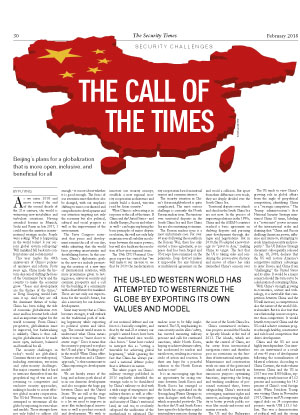Beijing’s plans for a globalization that is more open, inclusive, and beneficial for all
As we enter 2018 and move toward the end of the second decade of the 21st century, the world is witnessing new instabilities and turbulent situations. Having attended forums in Munich, Sochi and Rome in late 2017, I could sense the anxieties in international strategic circles. People were asking: What is happening in the world today? Is our current global system collapsing? Will mankind fall back into confrontations and isolationism?
This year marks the 40th anniversary of China’s policies of openness and reform. Forty years ago, China made the historic decision of shifting the focus of the Communist Party and the country to make the economy grow. “Peace and development are the themes of the times,” as Deng Xiaoping would later sum it up. And they are still the dominant themes of today. China has been riding the tide of economic globalization ever since and has become both a hub and an important engine for the world economy. From China’s perspective, globalization must be improved, but backtracking is unlikely. China is thus calling for globalization to be made more open, inclusive, balanced and beneficial for all.
The security challenges in today’s world are globalized. Common threats are widespread, including extremism, terrorism and cybersecurity challenges. But major countries find it hard to extricate themselves from the geopolitical tug of war and are returning to competitive and exclusive security approaches, making it harder to create effective global security cooperation. The US-led Western world has attempted to westernize all the globe by exporting its own values and models. Those attempts have not only failed to address old problems but have also created new ones.
China is not pursuing its development goals in a vacuum. We need a peaceful international environment. We need to engage in more extensive and comprehensive cooperation with the rest of the world. As President Xi Jinping said in his Geneva speech on Jan. 18, 2017: “China will do well only when the world does well, and vice versa.”
The 19th CPC National Congress established China’s new central leadership with President Xi at its core, and “The Xi Jinping Thought on Socialism with Chinese Characteristics for a New Era” was adopted as the guide to China’s development. It mapped out the objective of completing the building of a moderately prosperous society in all respects by 2020 and turning China into a great modern socialist country in two steps by 2050. It also charted the course for China’s economic policy over the next couple of years. China’s economy has been going through a transition from a phase of rapid growth to one of quality development. Put more simply, whereas our concern had been about whether there is enough – it is now about whether it is good enough. The focus of our attention must therefore also be changed, with our emphasis shifting to more coordinated and comprehensive development and our attention targeting not only the economy but also political, cultural and social progress as well as the improvement of the environment.
The Party Congress reiterated that peace and development remain the call of our day, while admitting that the world faces growing uncertainties and destabilizing factors. In this context, China’s diplomatic goals in the new era include promoting the creation of a new type of international relations, with more prominence given to lasting peace, universal security and common prosperity and a call for the building of a community with a shared future for mankind. These are not only our expectations for the world’s future, but also a necessity for our domestic development.
Some may worry that as China becomes stronger, it will embark on the traditional path of seeking hegemony while exporting its political system and ideology. The outside world wants to understand what China means when it vows to “move closer to center stage.” Does it mean that the country is prepared to replace the US and play a “leading role” in the world? When China offers “Chinese wisdom and a Chinese approach,” is that tantamount to China exporting its development model?
We are keenly aware of the long and arduous path ahead of us in our domestic development and also recognize the huge gap between China and the United States. We are still at the stage of learning and growing. There is a lot we need to improve in areas like technological innovation as well as product research and development. We wish to play a role in world affairs and make an even greater contribution to mankind. But it must be done within our means and in a manner consistent with our values.
China has offered a new option to countries that seek rapid development while retaining their independence. But this does not mean that China’s model and ideology are to be exported. The success of China proves that there are alternative options to those proposed by the West. Yet China is not interested in the so-called “competition of systems.”
In the realm of security, the pursuit of exclusive security by the United States and its alliance will unavoidably clash with the security interests of countries outside their alignment. Furthermore, countries not belonging to any alliance also face challenges in the handling of security differences between them. It is therefore important that all countries work together to set out some basic common principles.
In 2014, President Xi proposed that “we should actively advocate a common, comprehensive, cooperative and sustainable security strategy for Asia. We need to innovate our security concept, establish a new regional security cooperation architecture and jointly build a shared, win-win road for Asian security.”
What China is advocating is in response to the call of the times. If China and the United States – and ideally Europe, Russia and others as well – can begin exploring the basic principles of major dispute resolution, this will not only help maintain overall stability in relations between the major powers, but will also facilitate the resolution of hot-spot regional issues.
The 19th CPC National Congress report has stated that “we will make it our mission to see that by 2035 the modernization of our national defense and our forces is basically complete, and that by the mid-21st century our people’s armed forces have been fully transformed into world-class forces.” Some have rushed to interpret this as “setting a timetable for achieving global hegemony,” while ignoring the fact that China has always pursued a national defense policy that is defensive in nature.
The white paper on China’s military strategy published in 2015 explicitly identified the strategic tasks to be shouldered by China’s military: to deal with a wide range of emergencies and military threats as well as effectively safeguard the sovereignty and security of China’s territorial land, air and sea; to resolutely safeguard the unification of the motherland; to safeguard China’s security and interests in new domains; to safeguard the security of China’s overseas interests; to maintain strategic deterrence and carry out a nuclear counterattack; to participate in regional and international security cooperation and maintain regional and world peace; to strengthen efforts in operations against infiltration, separatism and terrorism so as to maintain China’s political security and social stability; and to perform such tasks as emergency rescue and disaster relief, rights and interests protection, domestic safety, and support for national economic and social development.
The white paper also pointed out that “the armed forces will actively participate in both regional and international security cooperation and safeguard overseas interests.” However, China’s approach regarding its overseas interests is not exclusionary or confrontational. China has vowed never to pursue hegemony nor to seek spheres of influence, military alliances or expansion. China will not fall into the trap of “strategic competition” with other powers. We will remain committed to international security cooperation based on mutual respect and common interest.
The security situation in China’s Asian neighborhood is quite complicated. The most serious challenge is currently the North Korean nuclear issue. The tensions over territorial disputes in the South China Sea and East China Sea are also continuing to simmer.
The Korean nuclear issue is a most unfortunate case. For over 60 years following the ceasefire in the Korean War, there has only existed a truce agreement, as no peace deal has been forged and US troops have remained on the peninsula. Deep distrust makes it impossible for any bilateral or multilateral agreement on the nuclear issue to be fully implemented. The US, emphasizing its own security and its allies’ safety, has exerted mounting military pressure and calls for continued sanctions, while North Korea, hoping to achieve ultimate safety, has accelerated its nuclear and missile tests, resulting in a vicious circle of action and reaction. Is there any hope for a peaceful solution to the North Korean nuclear issue?
It is an encouraging sign that an opportunity for easing tensions between South Korea and North Korea has emerged as the South has capitalized on the Pyeongchang Winter Olympics to open dialogues with the North, which responded positively. The fact that the US and South Korea have agreed to delay their regular joint military exercises during the Winter Games in February and March has paved the way for future talks and consultations. This can be seen in part as an early-stage implementation of the “suspension for suspension” idea, which China has been promoting – suspension of nuclear and missile tests and suspension of military maneuvers.
While China believes that sanctions are necessary and has fully complied with the UN Security Council resolutions concerning sanctions on North Korea, we also hold that sanctions only work when the door for negotiation is open. For this reason, China has made painstaking efforts to promote dialogue and negotiation.
China-US coordination is essential. Since President Donald Trump took office, the relationship between China and the US has been smooth, with both countries demonstrating a willingness to tackle bilateral issues and avoid a collision. But apart from their differences over trade, they are deeply divided over the South China Sea.
Territorial disputes over islands and shoals in the South China Sea are not new. In the process of improving relations in the 1990s, China and the ASEAN countries reached a basic agreement on shelving disputes and pursuing joint development through dialogue and negotiations. But in 2010, the US adopted a new strategy: its “pivot to Asia,” making China its target. The fact that the US is taking sides and condoning the provocative rhetoric and moves of others has only intensified China’s concern over the issue of the South China Sea.
China commenced reclamation projects around the Nansha or Spratly Islands at the end of 2013. The islands, which are under the control of China, are far away from international navigation routes and therefore pose no restriction on the freedom of international navigation. Maintenance and construction work on some of the garrisoned islands and reefs had merely an innocuous purpose: optimizing functions, improving the living and working conditions of personnel stationed there, better safeguarding China’s territorial sovereignty, maritime rights and interests, and improving the ability to better provide public services like search-and-rescue and marine research.
The US and the Philippines reacted strongly and criticized China. Some other countries in the area also expressed concerns. The Philippines even brought an arbitration case without the prior consultation of China, as was required according to the UN Convention on the Law of the Sea. The case was rejected by China. The US also stepped up its intervention, sending ships to sail near the Chinese islands and shoals. Yet China will not surrender its territorial sovereignty and corresponding maritime rights, nor will it condone other parties intervening in disputes between China and its neighbors. The differences between China and the US regarding these disputes have the potential to become the major point of tension in the South China Sea.
Progress is currently being made in negotiations on the Code of Conduct in the South China Sea (COC) between China and ASEAN countries. China has no agenda or motive to seek hegemony in the region. Future development is in the hands of the parties involved, where the choice of cooperation may lead to a “multi-win” outcome, while opting for confrontation or even conflicts would make everyone a loser.
The US tends to view China’s growing role in global affairs from the angle of geopolitical competition, identifying China as a “strategic competitor.” The Trump administration’s first National Security Strategy mentioned China 33 times, labeling it a “revisionist” power in terms of the international order and claiming that “China and Russia challenge American power, influence and interests, attempting to erode American security and prosperity.” The US Defense Strategy document subsequently released on Jan. 18, 2018, declares that the US will restore America’s competitive military advantage to deter Russia and China from “challenging” the United States and its allies. It would be a major concern should this turn out to be a declaration of containing China.
With China’s strength growing in economics, science and technology, it is inevitable that competition between China and the US will increase, as competition is also the nature of the world’s liberal market. But it is also true that our relationship is more cooperative than competitive. It would benefit everyone if China and the US could achieve common progress through healthy, constructive and rule-based competition that drives development.
China and the US are now highly interdependent. Our interests are intertwined as a result of over 40 years of development following the normalization of bilateral relations. According to China Customs, the trade volume between China and the US in 2017 was over $580 billion, representing a yearly increase of 15.2 percent and accounting for 14.2 percent of China’s total foreign trade. When President Trump was visiting China in November 2017, Chinese and US companies signed deals on 34 cooperation projects worth US$ 253.5 billion. This was a demonstration of political will and the strong business potential between the two countries.
The Chinese approach to addressing the trade imbalance with the US is to make the “cake” bigger instead of imposing restrictions. The US should relax its export controls and promote exports of high-tech products to China, fulfilling its obligations under Article 15 of the Protocol on China’s Accession to the WTO. It should also treat investment by Chinese companies in the US fairly while using trade remedy measures with caution. The two countries should not allow a trade war to compromise corporate interests and the people’s wellbeing.
Many of the new global challenges cannot be effectively tackled by one country alone. It is therefore imperative for the international community to join efforts. China hopes to establish a solid partnership based on mutual respect and shared interest with the US. Such a partnership, which adapts to the ever-changing reality, will enable both sides to better achieve their domestic objectives while coping with the challenges of today’s world.
FU YING
is chairperson of the Foreign Affairs Committee of the National People’s Congress of China.




